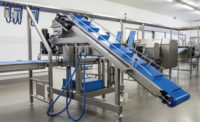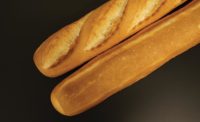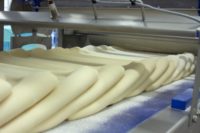As the final holidays of 2015 rapidly approach, many consumers will head to their favorite grocer or bakery to pick up decadent desserts, flaky pastries, artisan breads and other baked goods that they don’t have the time, tools or skills to make themselves. Commercial bakers, in turn, will rely on their trusty laminators and sheeters to create these products in quantities that enable their customers to meet shopper needs and wants.
And when the holidays are over, they’ll continue using these machines to make existing product lines—or perhaps try something new.
The benefits of ownership
“We are seeing lamination used a lot in bread production,” says Eric W. Riggle, vice president, Rademaker, Hudson, OH. “Lamination has two effects: One is on product volume—the lamination and layering of the dough provides for more volume in the proof and power in the bake. Second, with lamination you can control dough sheet width and therefore reduce the amount of side trim that needs to be accounted for in the production process.”
Rademaker introduced its updated Sigma laminator—which handles croissants, Danish, artisan breads, pizza crusts and puff pastry—at iba 2015 in Munich. “This was not a wholesale change to our laminating approach, but small, yet important, upgrades to the functionality of the laminator and sheeting line,” Riggle explains. The upgrades include wider sheeting rollers and conveyor frames for higher throughput, wider sheeting capacity and reduced stress in dough edges, more operator interface screen offerings, lifetime lubricated bearings in the product zone, an open belt design with rounded edges and covers, conveyor belt drying lifts, and high-efficiency motors and drives.
Riggle says that the company also introduced its cost-of-ownership model to clients at iba, which enables them to calculate the impact efficiency and product yield, as well as reduced downtime, sanitation and maintenance, have on their bottom line. “Our lines are designed to run longer with less downtime,” he explains. “When downtime is required, it is quicker and easier to perform.” That way, operations can get the line back up and into production faster.
According to Richard Breeswine, president and CEO, Koenig Bakery Systems, Ashland, VA, the No. 1 trend driving the market for sheeting and laminating lines is growing demand for high-quality, artisanal products, such as rolls, ciabatta, baguettes and flatbreads. In response, the company unveiled a new version of its Menes sheeting line at iba 2015. Menes’ modular design enables producers to add components at any time that meet their specific needs and can handle a wide range of products—from buns and breads to pastry.
The Menes line offers numerous other features, including high weight accuracy, along with perfect artisanal and stress-free product quality. Dough throughput is up to 5,000 kilograms per hour (approximately 11,000 pounds). The line has multiple working widths, and a dough belt former called Infeed with width adjustment for a homogeneous dough sheet from the start.
According to Breeswine, machine durability, easy operation, low maintenance, and service and parts support in the country where the equipment is installed are other benefits operators can realize.
“The beauty of sheeting equipment is that it’s so flexible,” says David Moline, sales and marketing manager, Moline Machinery LLC, Duluth, MN, which offers the Libra series of dough sheeters. “It can be used to make anything—flatbreads, ciabatta, cookies, pie crusts, tortillas, biscuits.”
Moline attributes sheeting equipment’s versatility to the sheeting process itself, which, he says, can be very similar for vastly different products and, thus, dictate use of the same equipment. “There are just a few key sections of sheeting systems that really dictate what kind of products you’re going to make,” he explains. “Dough forming is critical. The first questions we ask are, ‘What is the product? What is the grain structure?’ That dictates the kind of dough former you use. You can go from using a three-roll dough former and making a tight-grained, cracker-style product to using our Yoga relaxed dough former and making a ciabatta-type product.”
The Libra series features single, dual and triple dough sheeters, which can be operated by one trained person. “Sheeting equipment requires knowledgeable operators,” says Moline. “We’ve got a dozen engineers and three American Bakers Association–certified bakers who travel regularly to do maintenance, operational and sanitation training on our systems.”
Extrusion sheeting and snacks
Like bakers, some snack manufacturers are investing in laminating and sheeting equipment to address consumer snacking trends. One of the main trends in today’s snack market, says Keith Graham, marketing manager, Baker Perkins Ltd., Peterborough, England, is the emergence of “high-protein and high-fiber products aimed at consumers who want to maintain a balanced diet while grazing or eating on-the-go. Twin-screw extrusion is an easy way of incorporating such ingredients into snacks and in a format that will appeal to adults concerned with health.”
Extrusion sheeting—the newest addition to the Baker Perkins range of sheeting technologies—uses a twin-screw extruder with a wide slot die to produce a thin sheet of dough directly feeding into a rotary cutter. The process can be used to make any type of baked or fried snack that is cut from a sheet of dough.
Graham cites “free-from” products—made without nuts, wheat, dairy, GMOs and other ingredients that some people want to avoid—as another trend impacting the snack industry. “For manufacturers intending to make products for this market, extrusion provides the flexibility to make a wide variety of products from alternative ingredients,” he says.
The extrusion process supports dedicated lines running at high output, according to Graham, while the low cost and flexibility of the lines make producing small batches of products like snack crackers economically viable. When an extruder is not being used to manufacture these products, it can quickly and easily be used to produce direct-expanded curls or balls, coextruded filled pillows, bars, wafers, and other products.
Baker Perkins offers extruders in various sizes with outputs ranging from 500 to 1,500 kilograms (1,100 to 3,300 pounds) per hour. Its existing extruders can be adapted to accept the new sheeting dies.
Because extrusion sheeting replaces the mixer, dough feeder, sheeter and gauge rolls used in conventional sheeting, the process helps manufacturers reduce their capital investment and floor space requirements. Fewer components also make the lines simpler to operate and easier to clean, reducing maintenance costs and sanitation time.
“Although twin-screw extrusion has been a mainstay process in the snack industry for a long time, the appearance and texture of extruded snacks is not to everyone’s taste,” says Graham. “Extrusion sheeting overcomes this problem by allowing the creation of snacks with all the characteristics of traditionally sheeted products.”
Given growing consumer demand for artisanal baked goods and better-for-you snacks—and manufacturers’ interest in equipment that offers production versatility—flexible laminators and sheeters are quickly becoming go-to equipment for today’s bakers and snack producers.









